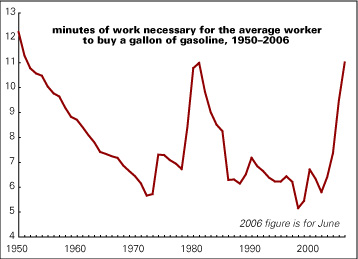Snap-On - Is the Value Cavalry Coming?
Snap-On Inc (SNA) is one of those great brands that seems to have lived mostly on its legacy, its great brand name, and has shown glacial improvement over the years. Its manufacturing efficiencies seem to be improving after many years of seeming neglect. Lots of room to improve yet. Its dealers seem to experience a lot of turnover, a problem that the company has addressed for some years. The dealer count dropped 5% in 2005, not exactly a glowing endorsement of the model. Because of dealer turnover, the company seems to be in a continuous struggle to find new dealers, and consequently, sales suffer.
SNA manufactures branded hand tools and diagnostic devices and equipment to automobile service professionals. There are over 14,000 products in its catalog.The Snap-On man sells as he always has to auto mechanics who he visits on his regular route. The commercial and industrial group sells directly and through distributors to transportation service, industrial, educational, construction and electrical businesses.
Growing complexity of automotive repair drives the automotive diagnostic business. The company achieves customer brand loyalty by its involvement with mechanic’s training...some 7 of 10 auto mechanics train with SNA equipment and tools.
This is a global enterprise with 63% of sales in North America, 30% in Europe, 1% in Emerging Markets, 4% in Australia/Japan, and 2% in Latin America.
In an amended 13D filing on the company, ValueAct Capital, a group I very much admire, disclosed a 6.6% (3.842 million share) stake in the company, which is up from the 5.4% stake the firm disclosed in the original 13D filing in November of last year. Please see 13_D Tracker. Is this the Value Cavalry that will rescue long time shareholders from the quagmire? Why quagmire?
| 1996 | 2001 | TTM | |
| Revenues | $1,485.3 | $2,095.7 | $2,354.1 |
Operating Income | $220.5 | $100.3 | $173.1 |
Operating Margin | 14.85% | 4.79% | 7.35% |
| E.P.S. | $2.16 | $0.37 | $1.65 |
| Free Cash Flow | $77.4 | $110.1 | $187.7 |
Revenue growth in the last five years has compounded at merely 2.35%.Operating margins remain at about half the levels of ten years ago, but have made some slight improvement since the bottom in 2001. Free cash flow has imroved substantially, where FCF margin currently runs at about 8% of sales.
| TTM | 2004 | 2003 | 2002 | 2001 | |
| Return on Equity | 8.2% | 7.4% | 7.8% | 13.0% | 9.1% |
| Return on Capital | 6.9% | 6.2% | 6.0% | 9.5% | 5.8% |
Returns on Capital have improved somewhat, but remain well below that of other companies in similar businesses such as Danaher which has a ROIC of 15.1% or Stanley Works with 11.8%. Returns on equity are also below those of DHR or SWK.
The company has bought back $220 million of stock in the last two years relative to issuance of $176 million, for a net buy back of about $44 million.This compares to essentially nil prior to the last two years. Five year compounded growth in the dividend has been merely 1.25%.
The recently reported second quarter surprised the Street on the upside, with operating margins at 9.1%.
I believe that this business is capable of far more, and clearly, management is starting to accelerate the pace. Historically, this has been a business that was capable of producing returns on equity at 20%. Perhaps, the Value Act management will use its moral suasion and influence to instill more rapid change.
Disclaimer:Neither I, my family, nor clients have a current position in Snap-On Inc., Danaher, or Stanley Works.



